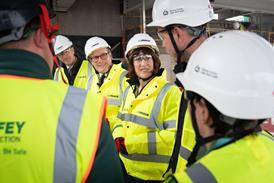Demand for affordable housing in London has never been higher. A record number of Londoners are living in temporary accommodation, a situation costing the taxpayer millions. This can only be resolved by a rapid increase in the number of available, affordable homes. Yet according to the latest data from the Greater London Authority, a total of 582 grant-funded affordable homes started construction and 2,697 were completed during the first half of the 2024-25 financial year. As a result, 90% of homes promised by the Mayor of London by 2026 must start construction in the next two years.

Meanwhile, high property prices are forcing people to consider renting, resulting in inflated rental costs further exacerbated by high-net-worth individuals seeking premium rental accommodation.
These challenges are substantial but not insurmountable. As a lawyer with over 20 years’ experience in housing and regeneration, I have advised registered providers, local authorities and private developers, supporting them in finding innovative legal solutions.
Challenges
London has set a number of ambitious housebuilding targets, but last November Sadiq Khan conceded that his latest target will likely be missed without additional funding. Much of this is a result of a ‘perfect storm’ of legal and practical challenges.
The Building Safety Act of 2022 has compelled providers to channel funding into remediating existing stock for cladding issues. There is also Awab’s Law and the remediation of damp and mould. These are certainly issues that need addressing – as recent history has demonstrated. However, the widespread nature of the issues and the cost of permanently resolving them have resulted in huge expenses and dramatically reduced funding for new housebuilding.
Meanwhile, cost of construction has grown significantly over recent years – and is projected to continue rising. A 2024 report from UK Finance suggested that construction costs have risen by 15-20% since 2020, largely due to rising prices of materials including steel, timber, and cement. Last September, the Building Cost Information Service projected a further 15% rise over the next five years. The situation has been made worse by continued higher interest rates on lending, as the construction industry, more than many other industries, is dependent on borrowing and financing for projects.
Alongside the government’s new housebuilding targets, relaxations on the use of green belt land have been introduced. However, the status of the Procurement Act is causing concern. Many local authorities want to bring green belt sites to market, but with rumours of delays to the implementation date (currently scheduled for 24 February), many providers are finding themselves in limbo and unable to do so.
Solutions
The simplest solution is also the most obvious – extra funding. Chancellor Rachel Reeves has already confirmed in her inaugural budget a £500m top-up for the 2021-26 Affordable Homes Programme, £100m of which will be allocated to London. This is very welcome, but Khan has indicated that it will not be enough by itself. He told the Local Democracy Reporting Service in November that he has a ‘number of asks’ of the government, including ‘additional support financially, in relation to affordable housing’.
But while government support can make a difference, developers are not sitting and waiting for intervention.
It is generally considered that cities overflowing into surrounding areas is no longer a smart solution to the housing crisis. Instead, regenerating older buildings and estates can be a more sustainable and efficient way of increasing the UK’s affordable housing stock. Many London councils are already using regeneration as a means of improving housing and increasing the number of homes available for sale. Regeneration is a win-win whereby residents will get a more modern and energy-efficient home, while pressures on council waiting lists will be reduced.
To progress these regeneration schemes, local authorities are exploring partnerships for delivering schemes which help ease the financial burden on the associated parties and, more recently, investment partnerships. These partnerships are comparable to a marriage, where culture, values and goals must be aligned. These arrangements often require a number of legal considerations involving procurement, planning, tax, construction and banking. I have often acted as a project lead, representing these varying interests and helping strike a favourable agreement between the two parties.
I was the recent project lead advising affordable housing provider SNG (Sovereign Network Group) on its purchase of homes in Brent Cross Town, as part of the Brent Cross Cricklewood regeneration project. Brent Cross Town is a new mixed-use town which is being delivered by a joint venture between Barnet Council and urban regeneration specialist Related Argent. It is the biggest regeneration and growth programme undertaken by Barnet Council. When complete, it will provide 6,700 homes and regenerate local health and education services.
The challenges in London’s housing market cannot be overestimated, but there is reason for optimism. I have seen creative and innovative new schemes and collaborations emerge, and remain optimistic. I am also excited to see what will be unveiled in the spring spending review, which has been touted by Angela Rayner as the ‘growth budget’.
It is now the job of the legal sector to work hand in hand with providers, developers and local authorities to support and advise on the growth and expansion of these new ways to deliver more housing in the capital.
Shazia Bashir is a housing and regeneration partner at TLT, London





























No comments yet